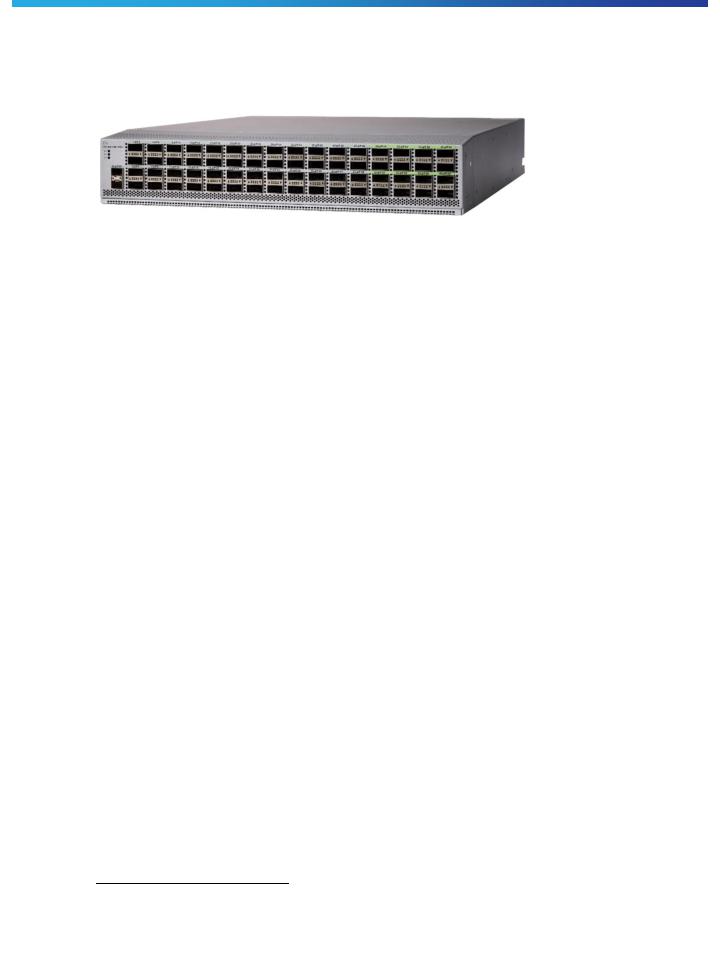Cisco Nexus 9364C User Manual

Data Sheet
Cisco Nexus 9364C Switch: Cisco NX-OS Fixed
Spine Switch
Product overview
Based on Cisco® Cloud Scale technology, the Cisco Nexus® 9300 platform consists of industry-leading, ultra-high- density fixed-configuration data center switches with line-rate Layer 2 and 3 features that support enterprise and commercial applications, service provider hosting, and cloud computing environments.
The next-generation Cisco Nexus 9364C Switch is the first 64-port 100-Gbps fixed switch on the market to offer a single Application-Specific Integrated Circuit (ASIC) architecture. The 9364C offers diversified connectivity with speed combinations of 1, 10, 40, and 100 Gbps for multiple use cases to meet the changing needs of virtualized data centers and automated cloud environments. Using the industry-leading Cisco NX-OS Software operating system, the 9364C spine switch offers flexibility, mobility, investment protection, and scale for service providers, enterprises, Infrastructure-as-a-Service (IaaS) solutions, and cloud providers. Designed for the programmable network, the NX-OS operating system automates configuration and management for customers who want to take advantage of the DevOps operation model and tool sets.
The product is designed to support innovative technologies such as Media Access Control Security (MACsec), Virtual Extensible LAN (VXLAN) tunnel endpoint VTEP–to–VTEP overlay encryption, and Streaming Statistics Export (SSX)1. MACsec is a security technology that allows traffic encryption at the physical layer and provides secure server, border leaf, and leaf-to-spine connectivity. SSX is hardware based, consisting of a module that reads statistics from the ASIC and sends them to a remote server for analysis. Through this application, users can better understand network performance without any impact on the switch control plane or CPU.
Model
Table 1 summarizes the Cisco Nexus 9364C Fixed Spine Switch.
Table 1. |
Cisco Nexus 9300 Platform Switches |
|
|
|
|
Model |
|
Description |
|
|
|
Cisco Nexus 9364C Switch |
64 x 40/100-Gbps Quad Small Form-Factor Pluggable 28 (QSFP28) ports and 2 x 1/10-Gbps Enhanced SFP |
|
|
|
(SFP+) ports |
|
|
|
* Check the support and port configuration details in Table 2.
The 9364C spine switch with NX-OS supports up to 12.84 Tbps of bandwidth across 64 fixed 40/100-Gbps QSFP28 ports2 and 2 fixed 1/10-Gbps SFP+ ports (Figure 1). The last 16 ports, marked in green, support wire-rate MACsec. The switch supports up to 4.3 billion packets per second (bpps) in a 2-Rack-Unit (2RU) form factor, flexible Ternary Content-Addressable Memory (TCAM) templates, VXLAN routing, and buffer capacity of 40 MB.
1Software support is on the roadmap. See the latest release notes for additional information.
2Ports 1-64 do not support breakout.
© 2018 Cisco and/or its affiliates. All rights reserved. This document is Cisco Public Information. |
Page 1 of 6 |

Figure 1. Cisco Nexus 9364C Switch
Specifications
Table 2 lists the specifications for the Cisco Nexus 9364C Switch. (Refer to the Cisco NX-OS Software release notes for feature support information.)
Table 2. |
Cisco Nexus 9364 Spine Switch specifications |
|
|
|
|
Item |
|
Specifications |
|
|
|
Physical |
|
● 64 x 40/100-Gbps QSFP28 ports and 2 x 1/10-Gbps SFP+ ports |
|
|
● 1200 Watt (W) AC power supplies or 930W DC power supplies (up to 2) |
|
|
● 80 Plus Platinum-rated power supplies that provide at least 90% efficiency with 20% utilization |
|
|
● Port-side intake or port-side exhaust airflow direction |
|
|
● System memory: 32 GB |
|
|
● Solid-State Disk (SSD): 256 GB |
|
|
● USB: 1 port |
|
|
● RS-232 serial console ports: 1 |
|
|
● Management ports: 2 (1 x 10/100/1000BASE-T and 1 x 1-Gbps SFP+) |
|
|
● Broadwell-DE CPU: 4 cores |
|
|
|
Buffer |
|
● 40 MB |
|
|
|
Power and cooling |
● Power: 1200W AC, 930W DC3, or 1200W HVAC/HVDC |
|
|
|
● Input voltage: 100 to 240V* AC or –40 to –72V DC (minimum and maximum), –48 to –60V DC (nominal) |
|
|
* Supports input voltage of 100 to 120V for maximum output of 800W, and 200 to 240V for maximum output of |
|
|
1200W, PSU redundancy is not supported when used in 100-120V |
|
|
● Frequency: 50 to 60 Hz (AC) |
|
|
● Efficiency: 90% or greater (20 to 100% load) |
|
|
● RoHS compliance: Yes |
|
|
● Hot swappable: Yes |
|
|
● Port-side intake or port-side exhaust options |
|
|
● Typical power: 429W (AC) |
|
|
● Maximum power: 1245W (AC) |
|
|
|
Environmental |
● Physical (H x W x D): 3.38 x 17.37 x 22.27 in. (8.59 x 44.13 x 56.58 cm) |
|
|
|
● Weight: 36.9 lb 16.74kg with power supplies and fans, 27.4 lb, 12.43kg without power supplies and fans |
|
|
● Operating temperature: 32 to 104°F (0 to 40°C) |
|
|
● Nonoperating (storage) temperature: –40 to 158°F |
|
|
(–40 to 70°C) |
|
|
● Humidity: 5 to 85% (noncondensing) |
|
|
● Altitude: 0 to 13,123 ft (0 to 4000m) |
|
|
|
Acoustics |
|
● Fan speed at 40%: 76.7 dBA |
|
|
● Fan speed at 70%: 88.7 dBA |
|
|
● Fan speed at 100%: 97.4 dBA |
|
|
|
Mean Time Between |
● 257,860 hours |
|
Failure (MTBF) |
|
|
|
|
|
3 930W-DC PSU is supported in redundancy mode if 3.5W QSFP+ modules or Passive QSFP cables are used & the system is used in 40C ambient temp or less; for other optics or higher ambient temps, 930W-DC is supported with 2 PSU’s in nonredundancy mode only
© 2018 Cisco and/or its affiliates. All rights reserved. This document is Cisco Public Information. |
Page 2 of 6 |
